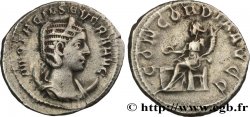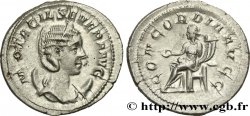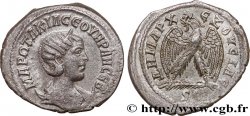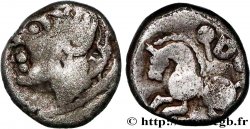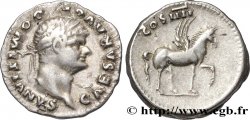Back 1/1
bpv_153815 - OTACILIA SEVERA Tétradrachme syro-phénicien
Not available.
Item sold on our e-shop (2011)
Price : 280.00 €
Item sold on our e-shop (2011)
Price : 280.00 €
Type : Tétradrachme syro-phénicien
Date: 245
Mint name / Town : Antioche, Syrie, Séleucie et Piérie
Metal : billon
Diameter : 28,00 mm
Orientation dies : 1 h.
Weight : 13,06 g.
Rarity : R3
Coments on the condition:
Flan court mais frappe bien centrée, usure limitée aux mèches de la tempe et au ventre de l’aigle
Catalogue references :
Obverse
Obverse description : Buste drapé et diadémé à gauche, les cheveux remontés en tresse sur la tête, posé sur un croissant de lune, vu de trois quarts de face.
Obverse legend : MAR WTAKIL SEOUHRAN SEB
Obverse translation : (Marcia Otacilia Severa augusta).
Reverse
Reverse legend : S|C À L’EXERGUE.
Reverse description : Aigle debout à gauche, les ailes déployées, tête à gauche et queue à droite, tenant une couronne feuillée dans son bec, posé sur une palme tige à droite.
Reverse legend : DHMARC - EX OUSIAS UPATOA
Reverse translation : (Revêtu de la puissance tribunitienne / Consul pour la première fois / avec l’accord du Sénat).
Commentary
Les frappes de Philippe II datées du premier consulat, comme celles d’Otacilie Sévère d’ailleurs, portent les titres de Philippe Père. Elles se distinguent entre elles par différents aigles de revers et un portrait à droite ou à gauche.
Il faut noter que si Philippe affectionne particulièrement la couronne radiée solaire dans ses frappes de tétradrachmes (sans que cela ait la moindre influence sur la valeur faciale de la monnaie, contrairement à ce qui se produit pour les antoniniens), tous les bustes de son épouse sont posés sur un croissant lunaire.
Après les frappes de l’atelier de Rome au MONVRB, les émissions de Philippe sont réorganisées à Antioche, le SC conservé et l’aigle est posé sur une palme. Le point essentiel est qu’elle sera présente jusqu’aux frappes du troisième consulat (il n’y a pas de frappes du deuxième consulat) puis reviendra pour toutes les émissions de Trajan Dèce avant de disparaître définitivement avec les frappes de Trébonien Galle et la fin des émissions de tétradrachmes.
La palme est un attribut monétaire récurrent à Antioche, soit dans le champ, soit sous les pattes de l’aigle du revers. A-t-elle toujours la même signification ? Impossible de le savoir. Théoriquement, la palme est le corollaire d’une onction, d’une fête, une décoration religieuse largement utilisée (voir la scène de l’arrivée du Christ à Jérusalem), et probablement, comme l’aigle, un symbole religieux œcuménique, destiné à être compris et accepté par tous les habitants de la région.
Le retour du SC, disparu des revers entre 242 et 244, après avoir remplacé à Antioche le Delta Eta apparu en 215, et jamais vu dans un autre atelier officiel, est confirmé. Si nous suivons la logique développée pour ces émissions, il faut croire que ces frappes de Philippe ont reçu l’assentiment (au moins) et le financement (au plus) du sénat d’Antioche. Une gigantesque rançon ayant été payée aux Perses pour abréger la guerre, le propre frère de Philippe étant gouverneur de Syrie, sa propre famille en étant originaire, on peut au moins penser que le Sénat regagna de son importance de l’époque des Sévères. La réputation de Priscus étant de pressurer la population - au point de susciter l’usurpateur Jotapian - on peut aussi penser que le produit de ces spoliations servit à frapper des tétradrachmes au portrait et donc à la gloire de l’Empereur.
On note que les sigma sont gravés en C.
Dans la base TSP maintenue par Michel Prieur, sept exemplaires sont maintenant répertoriés pour ce type, un seul en musée, à Princeton. Notre exemplaire est le 0343_003.
The coins of Philip II dated from the first consulate, like those of Otacilie Severe, bear the titles of Philip the Father. They are distinguished from each other by different reverse eagles and a portrait on the right or left.
It should be noted that while Philip was particularly fond of the radiating solar crown in his tetradrachm strikes (without this having the slightest influence on the face value of the coin, unlike what happens with the antoninianus), all the busts of his wife are placed on a lunar crescent..
After the strikes of the Rome workshop at MONVRB, the issues of Philip were reorganized in Antioch, the SC preserved and the eagle placed on a palm branch. The essential point is that it will be present until the strikes of the third consulate (there are no strikes of the second consulate) then will return for all the issues of Trajan Decius before disappearing definitively with the strikes of Trebonianus Gallus and the end of the issues of tetradrachms.
The palm is a recurring monetary attribute in Antioch, either in the field or under the paws of the eagle on the reverse. Does it still have the same meaning? It's impossible to know.. Theoretically, the palm is the corollary of an anointing, a feast, a widely used religious decoration (see the scene of Christ's arrival in Jerusalem), and probably, like the eagle, an ecumenical religious symbol, intended to be understood and accepted by all the inhabitants of the region..
The return of the SC, which disappeared from the reverses between 242 and 244, after having replaced in Antioch the Delta Eta which appeared in 215, and never seen in another official workshop, is confirmed. If we follow the logic developed for these emissions, we must believe that these strikes of Philip received the assent (at least) and the financing (at most) of the senate of Antioch. A gigantic ransom having been paid to the Persians to shorten the war, Philip's own brother being governor of Syria, his own family being from there, one can at least think that the Senate regained its importance of the time of the Severans. Priscus's reputation for squeezing the population - to the point of giving rise to the usurper Jotapian - we can also think that the product of these spoliations was used to strike tetradrachms with the portrait and therefore to the glory of the Emperor..
Note that the sigmas are engraved in C.
In the TSP database maintained by Michel Prieur, seven examples are now listed for this type, only one in a museum, in Princeton. Our example is 0343_003
Il faut noter que si Philippe affectionne particulièrement la couronne radiée solaire dans ses frappes de tétradrachmes (sans que cela ait la moindre influence sur la valeur faciale de la monnaie, contrairement à ce qui se produit pour les antoniniens), tous les bustes de son épouse sont posés sur un croissant lunaire.
Après les frappes de l’atelier de Rome au MONVRB, les émissions de Philippe sont réorganisées à Antioche, le SC conservé et l’aigle est posé sur une palme. Le point essentiel est qu’elle sera présente jusqu’aux frappes du troisième consulat (il n’y a pas de frappes du deuxième consulat) puis reviendra pour toutes les émissions de Trajan Dèce avant de disparaître définitivement avec les frappes de Trébonien Galle et la fin des émissions de tétradrachmes.
La palme est un attribut monétaire récurrent à Antioche, soit dans le champ, soit sous les pattes de l’aigle du revers. A-t-elle toujours la même signification ? Impossible de le savoir. Théoriquement, la palme est le corollaire d’une onction, d’une fête, une décoration religieuse largement utilisée (voir la scène de l’arrivée du Christ à Jérusalem), et probablement, comme l’aigle, un symbole religieux œcuménique, destiné à être compris et accepté par tous les habitants de la région.
Le retour du SC, disparu des revers entre 242 et 244, après avoir remplacé à Antioche le Delta Eta apparu en 215, et jamais vu dans un autre atelier officiel, est confirmé. Si nous suivons la logique développée pour ces émissions, il faut croire que ces frappes de Philippe ont reçu l’assentiment (au moins) et le financement (au plus) du sénat d’Antioche. Une gigantesque rançon ayant été payée aux Perses pour abréger la guerre, le propre frère de Philippe étant gouverneur de Syrie, sa propre famille en étant originaire, on peut au moins penser que le Sénat regagna de son importance de l’époque des Sévères. La réputation de Priscus étant de pressurer la population - au point de susciter l’usurpateur Jotapian - on peut aussi penser que le produit de ces spoliations servit à frapper des tétradrachmes au portrait et donc à la gloire de l’Empereur.
On note que les sigma sont gravés en C.
Dans la base TSP maintenue par Michel Prieur, sept exemplaires sont maintenant répertoriés pour ce type, un seul en musée, à Princeton. Notre exemplaire est le 0343_003.
The coins of Philip II dated from the first consulate, like those of Otacilie Severe, bear the titles of Philip the Father. They are distinguished from each other by different reverse eagles and a portrait on the right or left.
It should be noted that while Philip was particularly fond of the radiating solar crown in his tetradrachm strikes (without this having the slightest influence on the face value of the coin, unlike what happens with the antoninianus), all the busts of his wife are placed on a lunar crescent..
After the strikes of the Rome workshop at MONVRB, the issues of Philip were reorganized in Antioch, the SC preserved and the eagle placed on a palm branch. The essential point is that it will be present until the strikes of the third consulate (there are no strikes of the second consulate) then will return for all the issues of Trajan Decius before disappearing definitively with the strikes of Trebonianus Gallus and the end of the issues of tetradrachms.
The palm is a recurring monetary attribute in Antioch, either in the field or under the paws of the eagle on the reverse. Does it still have the same meaning? It's impossible to know.. Theoretically, the palm is the corollary of an anointing, a feast, a widely used religious decoration (see the scene of Christ's arrival in Jerusalem), and probably, like the eagle, an ecumenical religious symbol, intended to be understood and accepted by all the inhabitants of the region..
The return of the SC, which disappeared from the reverses between 242 and 244, after having replaced in Antioch the Delta Eta which appeared in 215, and never seen in another official workshop, is confirmed. If we follow the logic developed for these emissions, we must believe that these strikes of Philip received the assent (at least) and the financing (at most) of the senate of Antioch. A gigantic ransom having been paid to the Persians to shorten the war, Philip's own brother being governor of Syria, his own family being from there, one can at least think that the Senate regained its importance of the time of the Severans. Priscus's reputation for squeezing the population - to the point of giving rise to the usurper Jotapian - we can also think that the product of these spoliations was used to strike tetradrachms with the portrait and therefore to the glory of the Emperor..
Note that the sigmas are engraved in C.
In the TSP database maintained by Michel Prieur, seven examples are now listed for this type, only one in a museum, in Princeton. Our example is 0343_003







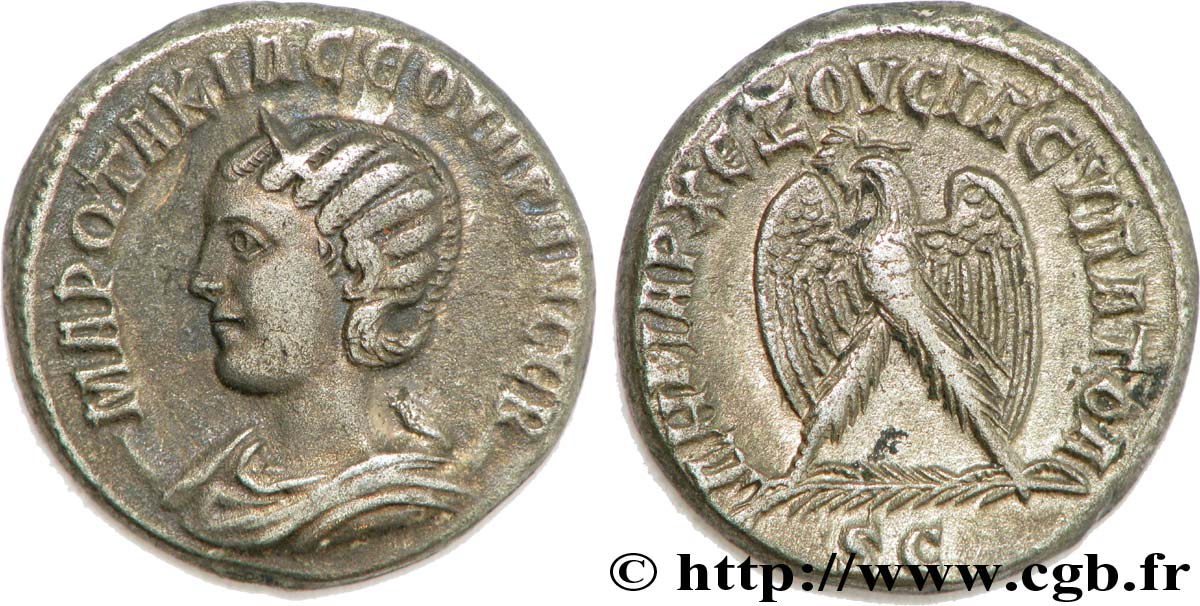
 Report a mistake
Report a mistake Print the page
Print the page Share my selection
Share my selection Ask a question
Ask a question Consign / sell
Consign / sell
 Full data
Full data

